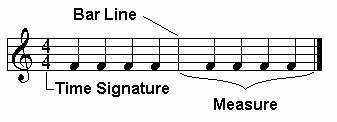Section 7: Bar Lines and Measures
In Figure I, there was another new element that we did not discuss. Go back and look at it again. The vertical line or separator between the notes and the rests is called a Bar Line. Bar lines separate sheet music into measures.
If you were to look at sheet music without bar lines and measures it would be just a string of notes and rests. Think of bar lines as the punctuation for music, like commas and periods for an essay or story, (See Figure J).

(Figure J)
Time Signature: A sign placed on a staff to indicate the meter, commonly a numerical fraction of which the numerator is the number of beats per measure and the denominator represents the kind of note getting one beat.
The segments of separated sections created by the use of bar lines are called Measures. They are always equal in count, meaning each measure represents a specific number of beats. Simplifying the definition, the number of beats and the value of the notes in each measure is defined by a Time Signature.
In Figure J, the time signature lets us know that there are four beats per measure, (the top number), and a quarter note gets one beat, (the bottom number).
Since a quarter note only gets one beat and there are four beats per measure, there are four quarter notes in a measure.
With an eighth note there will be eight per measure. An eighth is half of a quarter note. Going back up the duration lengths, there can be two half notes per measure since one half note is equal to two quarter notes.
There are many other time signatures as well, but most popular music is written in four-four time. Another more common type of time signature is seen most often in a waltz. It is called three-four time, or 3/4 time, (See Figure K).

(Figure K)
The dotted note comes in to play here. To fill a 3/4 measure with a single note you would not use a whole note, (4 beats), but rather a dotted half note. Remember that a "dot" next to a note or rest adds half the value of the note, so a half-note, (2 beats), plus half of the value of the note, (1 beat), would be three beats in duration, (the second measure in Figure K).
To separate a 3/4 count into two notes, you would use two dotted quarter notes, (each note having a one and one-half beat duration).
A dotted eighth note is the equivalent of 3 sixteenth notes or 3/4 of a beat in duration. Since a sixteenth note is 1/4 of a beat, instead of using four sixteenth notes to represent one beat, you can use a dotted eighth note and a sixteenth note. 3/4 and 1/4 equals 1.
The Triplet:
Before we move on I wanted to introduce you to two types of durations that are quite common. This pertains to rhythm but is easier to understand now that you are beginning to be familiar with how beats and durations work to create rhythm.
Subdividing is "splitting" a beat into different parts to create more complicated rhythms. Take a look at Figure K2 below. It shows a triplet being used in a 4/4 count.

(Figure K2)
The measure you are looking at is still four beats, however there are five notes. The last three notes is what is called a triplet, or three notes in the place of two. A triplet is the equivalent of two quarter notes and is identified by the "3" marked over it.
Triplets also have their durations. You can make triplets of quarter notes as in Figure K2, eighth notes as in figure K3 and so on.

(Figure K3)
Exercise:
To further understand the triplet used in Figure K3 we revisit the four-count clapping exercise. Begin to clap the four-count, 1, 2, 3 4. Now we add the verbal of a triplet. You would say "one - two - three - four-trip-let." As you can see, the quarter note was replaced with three notes.
They are not, however, 16th notes! They are what is called a twelfth, (12th) notes. Separate all four quarter notes into thirds and you would have twelve notes per measure, each note being a twelfth.
Other examples of subdividing are the duplet, or two notes in the place of three and indicated by a "2" and the quadruplet, or four notes in the place of three.
Study Figures J through K3 closely and pay attention to how the notes are broken down. Let us take a closer look at some other common time signatures.